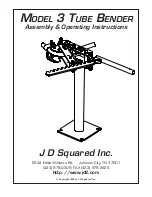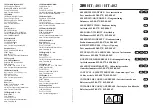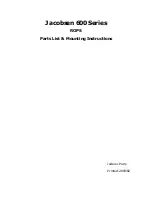
677484
Version date: 10.03.2017
FR
DE
FR
Tournevis-testeur
DE
Phasenprüfer
ES
Destornillador busca polos
Mains Tester
110 - 250V AC
silverlinetools.com
IT
Tester per rete elettrica
NL
Spanningstester
PL
Próbnik napięcia
Register online: silverlinetools.com
3
GUARANTEE
YEAR
AN
S D
E G
AR
AN
TIE
JA
HR
E G
AR
AN
TIE
AÑ
OS
DE
GA
RA
NT
ÍA
AN
NI
DI
GA
RA
NZ
IA
JA
AR
GA
RA
NT
IE
LA
TA
GW
AR
AN
CJ
I
GB
Safety Instructions
Carefully read and understand these instructions before use. Keep these instructions with the product for future
reference and ensure all persons who use this product read them.
Even when used as prescribed it is not possible to eliminate all residual risk factors. Use with caution. If you are at all
unsure of the correct and safe manner in which to use this tool, do not attempt to use it
• Comply with all local and national safety requirements
• Do not expose this product to extremes in temperature or high humidity
• The use of this product requires the user to be in very close proximity to live AC voltages. Take all necessary safety
precautions when using this tool
• It is important this tool is stored in dry conditions to prevent water entering the body of the tool, which could lead
to electrocution when used
• Do not use this tool if the insulation is damaged, cracked or incomplete
• Do not use this tool for any other purpose than it is designed for, especially any use which may damage the
insulation of the tool
WARNING:
Risk of electric shock and burns. Contact with live circuits could result in serious injury or even death
Application
This product is designed to easily and quickly detect AC voltage in power sockets, light fittings, circuit breakers, wires,
terminals and cables, and to find breaks in wires. It is suitable for use in domestic properties around the world that
operate between 110V-250V. It is not designed for detecting AC voltage in industrial premises which operate above
normal domestic AC voltages.
Operation
WARNING
• Before use: functional test!
• Do not use in moist or damp places or in high humidity!
• Only use for voltage testings
• Do not use defective voltage testers
• If the tester appears damaged or any part is loose, or if there is any indication of water ingress, DO NOT USE
• Do not use to test electrical circuits above 250V AC
• Always wear approved eye protection
Using this tool
IMPORTANT:
Before each use, test on a known working circuit that is within the rating of the tester. If the tester does not
indicate voltage is present, DO NOT USE
WARNING:
If there is no indication, do not assume for certain that AC voltage is not present. It is possible the connection
is intermittent or operating just below the range of the voltage tester
1. Make sure you are holding the voltage tester correctly with fingers positioned on the main handle and have one
finger touching the metal contact at the top of the handle. Keep your fingers at the maximum distance away
from the flat/slotted blade
2. Check to make sure the blade can safely touch the electrical point you wish to test without shorting to any
other contacts nearby. If there is any risk the blade will short across contacts do not use unless you are sure it
is safe to do so
3. Position the blade against the test point with light pressure, the bulb will indicate the presence of AC voltage
4. Carefully and quickly remove the voltage tester blade from the contact point
Notes:
• The light of the bulb varies with the level of voltage and current so ensure the surrounding light levels allow the light
from the bulb to be seen clearly
• Never use the voltage tester when damp or in rain or expose live contacts to the same conditions. Any water ingress
into the tool body makes the tool unsafe to use and must be replaced
• It is not advised to use this tool as a normal screwdriver, but when accessing screw terminals that relate to AC circuits,
it is recommended to use this tool as a safe guard in case the circuit is live
• This product does not meet the construction requirements of UK GS 38
CE Declaration of Conformity
The undersigned:
Mr Darrell Morris
as authorised by:
Silverline Tools
Declares that
This declaration has been issued under the sole responsibility of the manufacturer.
The object of the declaration is in conformity with the relevant Union harmonisation Legislation.
Identification code:
677484
Description:
Mains Tester
Conforms to the following directives and standards:
• Low Voltage Directive 2014/35/EU
• EMC Directive 2014/30/EU
• EN61010-1:2010
• EN61010-31:2015
• EN61326-1:2013
• EN61326-2-2:2013
Notified body:
Most Technology Service Co., Ltd.
The technical documentation is kept by:
Silverline Tools
Date:
11/11/16
Signed:
Mr Darrell Morris
Managing Director
Name and address of the manufacturer:
Powerbox International Limited, Company No. 06897059. Registered address: Powerbox, Boundary Way, Lufton
Trading Estate, Yeovil, Somerset BA22 8HZ, United Kingdom.
Specification
Indication type:
Neon Bulb
Voltage detection range:
110–250V AC
Frequency detection range:
50–400Hz
Operating temperature:
0°– 40°C
Product Familiarisation
Flat/Slotted Blade:
Makes electrical contact
Neon Bulb:
Indicator of AC voltage
Contact:
To touch to test for AC voltage
Danger: Risk of Electrocution
IMPORTANT:
The stated voltages are nominal voltages. Only use the voltage tester in this range.
Note:
The reading is not guaranteed in poor light conditions, on insulated surfaces or for non-earthed AC networks.
Consignes de sécurité
Lisez attentivement ce manuel avant l’utilisation. Conservez ces consignes avec l’outil, pour consultation ultérieure, et
assurez-vous que toute personne venant à utiliser cet outil ait attentivement pris connaissance de ce manuel.
Sachez qu’utiliser un outil conformément aux prescriptions n’élimine pas tout facteur de risque résiduel. Utilisez avec
prudence. N’utilisez pas cet outil si vous avez des doutes quant à la manière correcte et sûre de procéder.
• Conformez-vous aux exigences locales et nationales en matière de sécurité.
• N’exposez pas ce produit à des températures extrêmes ou à une forte humidité.
• Ce produit implique que l’utilisateur se trouve à grande proximité de tensions alternatives. Prenez toutes les
précautions d’usage au moment de manipuler cet instrument.
• Il est important que cet instrument soit conservé dans un environnement sec afin d’éviter toute pénétration d’eau, ce
qui pourrait conduire à une électrocution à l’usage.
• Ne pas utiliser l’instrument si l’isolation est endommagée, fêlée ou incomplète.
• Ne pas utiliser l’instrument à toute autre fin que celle pour laquelle il a été conçu, notamment si cela devait
endommager l’isolation de l’instrument.
AVERTISSEMENT :
risque de choc électrique et de brûlures. Tout contact avec le courant électrique peut engendrer des
blessures graves, voire la mort.
Domaine d’application
Ce produit est conçu pour détecter facilement et rapidement une tension alternative dans les prises murales, douilles de
lampe, coupe-circuits, fils, bornes et câbles électriques, et pour déceler les ruptures de fil. Il s’applique aux habitations
dans les endroits du monde où la tension du secteur est comprise entre 110 et 250 V. Il n’est pas conçu pour la détection
de tensions alternatives dans les bâtiments industriels dans lesquels la tension alternative est supérieure à celle des
habitations.
Fonctionnement
AVERTISSEMENT
• Avant toute utilisation, veillez à réaliser un test pour en vérifier le bon fonctionnement !
• Ne pas utiliser dans des endroits trempés ou humides ni en conditions de forte humidité atmosphérique.
• Ce testeur n’est indiqué que pour tester la tension.
• Un testeur défectueux ne doit en aucun cas être utilisé.
• Ne pas utiliser l’instrument s’il présente des signes de dommages ou d’usure ou si l’un de ses composants est
desserré, de même que s’il y a des signes indiquant que de l’eau a pu s’infiltrer à l’intérieur de l’appareil. Si vous
constatez l’un de ces signes : votre testeur NE DOIT EN AUCUN CAS ÊTRE UTILISÉ.
• Ne pas utiliser l’instrument pour tester des circuits électriques supérieurs à 250 V CA.
• Veillez à toujours porter une protection oculaire adaptée.
Utilisation de l’instrument
IMPORTANT :
avant toute utilisation, faites un essai sur un circuit dont vous savez qu’il fonctionne et dont vous
connaissez la tension. Si le testeur n’indique pas la présence d’un courant, NE L’UTILISEZ PAS.
AVERTISSEMENT :
si le testeur ne fournit aucune indication, ne considérez pas pour autant qu’il n’y ait aucune tension.
Il est possible que la connexion soit intermittente ou que la tension soit juste en-dessous de la plage prévue pour le
testeur.
1. Assurez-vous de tenir le testeur de tension en plaçant bien les doigts autour du manche, un doit touchant le
contact métallique sur le haut du manche. Tenez les doigts aussi éloignés que possible de la pointe plate.
2. Vérifiez que vous pourrez mettre la pointe en contact avec l’emplacement que vous souhaitez tester sans que ce
contact ne crée de court-circuit avec tout autre point de contact alentours. S’il existe un risque de court-circuit,
n’utilisez pas l’instrument à moins d’être sûr que cela soit sans danger.
3. Placez la pointe contre l’emplacement à tester en exerçant une légère pression. L’ampoule indiquera la présence
d’une tension alternative.
4. Retirez avec précaution, mais rapidement, la pointe du testeur de tension du point de contact.
Remarques :
• La lumière de l’ampoule varie avec la tension et l’intensité donc il est important de faire en sorte que l’éclairage
présent lors de l’opération permette de bien voir l’ampoule de l’instrument.
• Ne jamais utiliser le testeur de tension lorsqu’il est humide ou sous la pluie ni exposer les contacts électriques à ces
mêmes conditions. Toute pénétration d’eau à l’intérieur de l’instrument le rendra impropre à l’utilisation et il devra
être remplacé
• Il n’est pas recommandé d’utiliser cet instrument en guise de tournevis, mais en cas d’accès à des bornes à vis en
contact avec des circuits alternatifs, il est recommandé d’utiliser cet instrument pour contrôler la vis au cas où le
circuit serait sous tension.
Déclaration de conformité CE
Le soussigné :
M. Darrell Morris
Autorisé par :
Silverline Tools
Déclare que :
La présente déclaration est établie sous la responsabilité exclusive du fabricant.
La présente déclaration de conformité est rédigée conformément à la législation d’harmonisation de l’Union
Européenne pertinente
Déclare que le produit :
Code d’identification :
677484
Description :
Tournevis-testeur
Est conforme aux directives suivantes :
• Directive sur les basses tensions 2014/35/UE
• Directive sur la compatibilité électromagnétique 2014/30/UE
• EN61010-1:2010
• EN61010-31:2015
• EN61326-1:2013
• EN61326-2-2:2013
Organisme notifié :
Most Technology Service Co., Ltd.
La documentation technique est conservée par :
Silverline Tools
Date :
11/11/16
Signature :
M. Darrell Morris
Directeur général
Nom et adresse du fabricant ou de son représentant agréé :
Powerbox International Limited, entreprise enregistrée sous le numéro 06897059. Siège social : Powerbox,
Boundary Way, Lufton Trading Estate, Yeovil, Somerset BA22 8HZ, Royaume Uni.
Caractéristiques techniques
Type d’indicateur :
ampoule néon
Plage de détection de tension :
110 – 250 V CA
Plage de détection de fréquence :
50 – 400 Hz
Plage de température de service :
de 0° à + 40 °C
Présentation du produit
Pointe plate/fendue :
établit le
contact électrique
Ampoule au néon :
indicateur de
tension continue
Contact :
à toucher du doigt pour
tester la tension continue
Danger : Risque d’électrocution
IMPORTANT :
Les tensions indiquées sont des tensions nominales. Veiller à utiliser ce tournevis testeur uniquement
dans la plage de tension indiquée.
Remarque :
La fiabilité de la lecture du résultat ne peut être garantie lorsqu’elle résulte d’un test réalisé en conditions
de faible luminosité, sur des surfaces isolées ou sur un réseau électrique sans mise à la terre.
Sicherheitshinweise
Betreiben Sie das Gerät erst, wenn Sie diese Bedienungsanleitung sorgfältig gelesen und sich mit dem Inhalt vertraut
gemacht haben. Bewahren Sie alle Anleitungen mit dem Gerät für spätere Nachschlagezwecke auf. Vergewissern Sie
sich, dass alle Benutzer dieses Produkts diese Bedienungsanleitung vollständig verstanden haben.
Auch wenn dieses Gerät wie vorgeschrieben verwendet wird, ist es nicht möglich, sämtliche Restrisiken auszuschließen.
Mit Vorsicht verwenden. Sollten Sie sich in irgendeiner Weise unsicher bezüglich der sachgemäßen und sicheren
Benutzung dieses Gerätes sein, verwenden Sie es nicht.
• Beachten Sie alle regional und national geltenden Sicherheitsvorschriften.
• Setzen Sie dieses Gerät keinen extremen Temperaturen oder hoher Luftfeuchtigkeit aus.
• Der Benutzer begibt sich bei der Verwendung dieses Gerätes in die unmittelbare Nähe von spannungsführenden
Stromkreisen. Treffen Sie alle nötigen Vorsichtsmaßnahmen.
• Es ist wichtig, dass das Werkzeug stets in trockener Umgebung aufbewahrt und niemals nass wird, um mögliche
Elektroschocks zu vermeiden.
• Verwenden Sie dieses Werkzeug nicht, falls die Isolation teilweise fehlt, eingerissen oder anderweitig beschädigt ist.
• Verwenden Sie dieses Werkzeug niemals zweckentfremdet, insbesondere wenn die Isolierung des
Spannungsprüfers dabei beschädigt werden könnte
WARNUNG!
Es besteht das Risiko von elektrischen Schlägen und Verbrennungen. Kontakt mit spannungsführenden
Stromkreisen kann zu schwerwiegenden Verletzungen und/oder zum Tode führen.
Anwendung
Dieses Gerät ist zur Ortung von Spannung in Netzsteckdosen, Leuchtmittelfassungen, Trennschaltern, Leitungen und
Kabeln sowie zum Auffinden von Kabelbrüchen bestimmt. Es darf in Privathaushalten weltweit mit Netzspannungen
zwischen 110 und 250 V verwendet werden. Das Gerät ist nicht zur Verwendung mit Industriestromkreisen geeignet,
deren Spannung oberhalb der normalen Haushaltsnetzspannung liegt.
Bedienung
WARNUNG!
• Vor Gebrauch: Funktionstest!
• Nicht bei Feuchtigkeit, Nässe oder hoher Luftfeuchtigkeit verwenden!
• Nur zur Spannungsprüfung verwenden!
• Keine defekten Spannungsprüfer verwenden!
• Nicht verwenden, wenn das Gerät beschädigt erscheint, falls Teile lose sind oder falls das Gerät mit Wasser in Kontakt
gekommen ist!
• Nicht zum Prüfen von Wechselstromkreisen über 250 V verwenden!
• Stets geeigneten Augenschutz tragen!
Verwendung des Gerätes
ACHTUNG!
Überprüfen Sie das Gerät vor jedem Gebrauch an einer bekannten Spannungsquelle, deren Nennwerte sich
innerhalb des für den Spannungsprüfer geeigneten Spannungsbereiches befinden, auf Funktionstüchtigkeit. Falls das
Gerät dort keine Spannung anzeigt,
verwenden Sie es nicht!
WARNUNG!
Nehmen Sie nicht an, dass ein Stromkreis spannungsfrei ist, wenn das Gerät keine Spannung anzeigt. Es ist
möglich, dass ein Wackelkontakt vorliegt oder dass die Spannung unter dem Messbereich des Gerätes liegt.
1. Stellen Sie sicher, dass Sie den Spannungsprüfer stets auf die korrekte Art und Weise halten, mit den Fingern
auf dem Handgriff und einem Finger auf dem Berührungskontakt am Ende des Griffes. Halten Sie Ihre Finger so
weit wie möglich von der Schraubendreherspitze entfernt.
2. Vergewissern Sie sich, dass die Spitze des Gerätes die Prüfstelle sicher berührt, ohne dabei Kurzschlüsse mit
benachbarten Kontakten herzustellen. Falls ein Kurzschlussrisiko besteht, verwenden Sie das Gerät nur, falls Sie
sich absolut sicher sind, dass dies sicher möglich ist.
3. Berühren Sie die Prüfstelle mit leichtem Druck. Die Neonleuchte wird anliegende Wechselspannung innerhalb
des Messbereiches anzeigen.
4. Entfernen Sie den Spannungsprüfer mit einer schnellen, flüssigen Bewegung von der Prüfstelle.
Hinweise:
• Die Helligkeit der Neonleuchte hängt von der anliegenden Spannung ab. Stellen Sie sicher, dass Sie das Licht der
Leuchte trotz des Umgebungslichts mühelos ausmachen können.
• Verwenden Sie den Spannungsprüfer niemals, wenn dieser feucht geworden ist und setzen Sie spannungsführende
Teile niemals Feuchtigkeit aus. Falls Feuchtigkeit ins Innere des Gerätes eindringt, darf es nicht mehr verwendet
werden, sondern muss umgehend ersetzt werden.
• Es wird davon abgeraten, dieses Werkzeug als Schraubendreher einzusetzen. Es ist allerdings zum Anziehen von
spannungsführenden Klemmen geeignet, da möglicherweise anliegende Wechselspannung angezeigt wird.
• Beim Einsatz des Spannungsprüfers für den haushaltsüblichen Wechselstrom sollte das Gerät vor und nach der
Anwendung am eigentlichen Messobjekt immer an einem spannungsführenden Leiter geprüft werden.
CE-Konformitätserklärung
Name des Unterzeichners:
Mr. Darrell Morris
Bevollmächtigt durch:
Silverline Tools
Erklärt hiermit Folgendes:
Die alleinige Verantwortung für die Ausstellung dieser Erklärung trägt der Hersteller.
Der Gegenstand der Erklärung erfüllt die einschlägigen Harmonisierungsrechtsvorschriften der Gemeinschaft.
Produktkennung:
677484
Produktbezeichnung:
Phasenprüfer
Entspricht den folgenden Richtlinien und Normen:
• Niederspannungsrichtlinie 2014/35/EU
• EMV-Richtlinie 2014/30/EU
Benannte Stelle:
Most Technology Service Co., Ltd.
Techn. Unterlagen bei:
Silverline Tools
Datum:
11.11.2016
Unterzeichnet von:
Mr. Darrell Morris,
Geschäftsführender Direktor
Name und Anschrift des Herstellers:
Powerbox International Limited, Handelsregisternummer 06897059. Eingetragene Anschrift: Powerbox, Boundary
Way, Lufton Trading Estate, Yeovil, Somerset BA22 8HZ, Großbritannien
Technische Daten
Anzeigetyp:
Neonleuchte
Spannungsbereich:
110–250 V, Wechselspannung
Frequenzbereich:
50–400 Hz
Betriebstemperatur:
0– 40 °C
Achtung, Stromschlaggefahr!
ACHTUNG!
Bei den angegebenen Spannungswerten handelt es sich um die Nennspannung. Der Spannungsprüfer darf
nur im angegebenen Spannungsbereich verwendet werden.
Hinweis:
Bei schlechten Lichtverhältnissen, auf isolierten Flächen und in nicht geerdeten Wechselstromnetzen sind
korrekte Messwerte nicht gewährleistet.
Geräteübersicht
Flache Schlitzschraubendreherklinge:
zum
Herstellen des Prüfkontaktes
Neonleuchte:
zur Anzeige von
Wechselspannung
Berührungskontakt:
muss zur
Spannungsprüfung vom Benutzer
berührt werden
677484_Safety Sheet.indd 1
10/03/2017 10:47




















